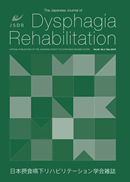Volume 2, Issue 1
The Japanese Journal of Dysphagia Rehabilitation
Displaying 1-9 of 9 articles from this issue
- |<
- <
- 1
- >
- >|
Review Article
-
1998Volume 2Issue 1 Pages 3-8
Published: December 20, 1998
Released on J-STAGE: May 24, 2019
Download PDF (2822K) -
1998Volume 2Issue 1 Pages 9-12
Published: January 31, 1998
Released on J-STAGE: May 24, 2019
Download PDF (1583K)
Original Paper
-
1998Volume 2Issue 1 Pages 13-22
Published: December 20, 1998
Released on J-STAGE: May 24, 2019
Download PDF (4179K) -
1998Volume 2Issue 1 Pages 23-28
Published: December 20, 1998
Released on J-STAGE: May 24, 2019
Download PDF (2347K) -
1998Volume 2Issue 1 Pages 29-35
Published: December 20, 1998
Released on J-STAGE: May 24, 2019
Download PDF (3116K)
Clinical Report
-
1998Volume 2Issue 1 Pages 36-39
Published: December 20, 1998
Released on J-STAGE: May 24, 2019
Download PDF (1838K) -
1998Volume 2Issue 1 Pages 40-43
Published: December 20, 1998
Released on J-STAGE: May 24, 2019
Download PDF (1747K) -
1998Volume 2Issue 1 Pages 44-48
Published: December 20, 1998
Released on J-STAGE: May 24, 2019
Download PDF (2223K) -
1998Volume 2Issue 1 Pages 49-54
Published: December 20, 1998
Released on J-STAGE: May 24, 2019
Download PDF (2463K)
- |<
- <
- 1
- >
- >|
